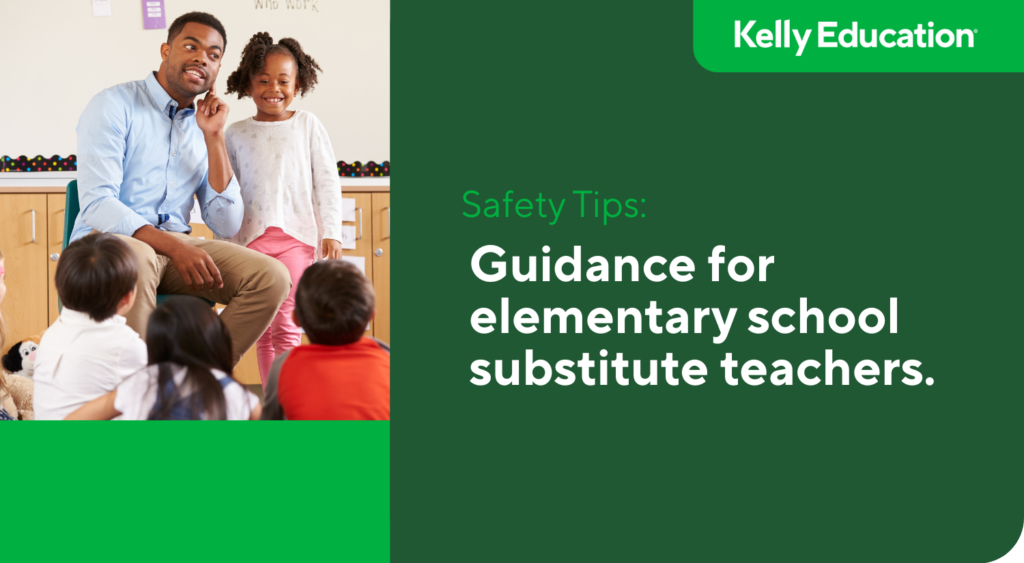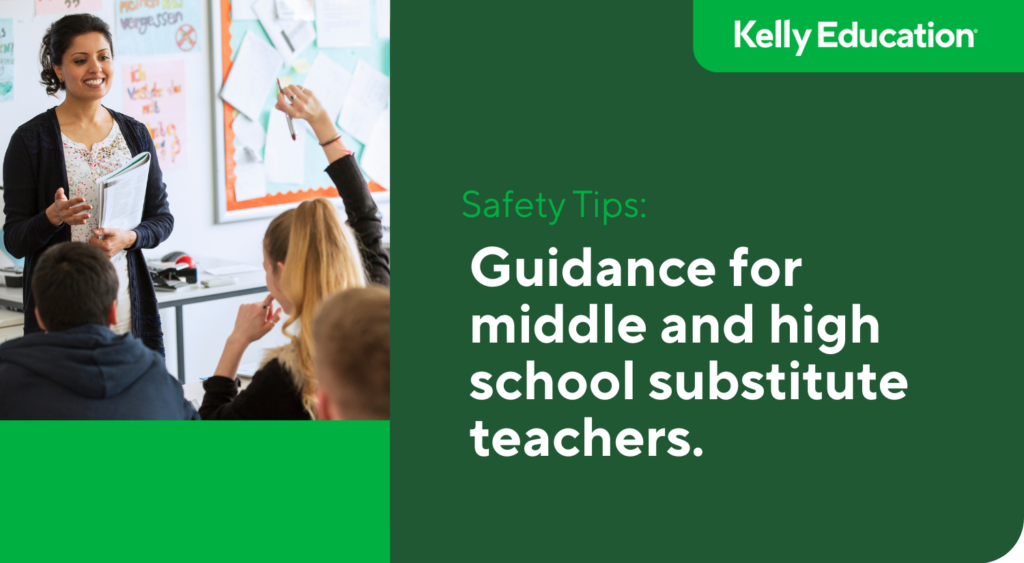Classroom management for substitute teachers.

Classroom management for substitute teachers refers to the actions a teacher takes to create an effective, successful learning environment. Whether you’re in a new room, a new school, or teaching a new set of students, it’s your job to keep the school day moving and students learning.
If it’s your first time in a new building, arriving early to talk to other teachers on your grade level team can help you get the information you need to anticipate student behaviors for your class. Also, paying attention to their behavior before school, at recess, and in the lunchroom can help you notice which students might benefit from a little extra attention.
Strategies for classroom management for substitute teachers:
- Build rapport with students.
- Foster engagement.
- Move closer to disruptive students.
- Always stay calm.
- Use attention getters.
- Narrate the positive behaviors you’d like to see.
The challenges of classroom management.
Before we share strategic solutions, let’s review some of the common challenges substitute teachers face:
- Minor student misbehavior: talking without raising their hands or working on something other than the work assigned for the class.
- Attention-seeking behaviors: making noises, speaking loudly, or purposely going against standard classroom routines.
- Low engagement in lessons or activities
- Breaking school or classroom rules: using electronic devices, eating and drinking in the classroom, or failing to follow proper hall pass procedures.
Having some tried-and-true classroom management strategies in your back pocket will make the difference between a successful day and one that quickly unravels. Links throughout provide additional depth on some of the strategies.
Build rapport.
The quicker you build rapport with students, the easier classroom management will be. Learning names, setting clear expectations up front, and being approachable are examples of ways to build rapport in a classroom.
As a substitute teacher, it’s not enough to give them a worksheet and sit back at your desk. Be fully present in your role as an educator. Even if the work the teacher has provided for the students doesn’t require active teaching, check in on progress, correct misunderstandings, and troubleshoot with them.
Foster engagement.
An excellent way to foster engagement as a substitute teacher is to walk around the classroom. When you do this, you can help students remain focused and feel comfortable to informally ask questions which improves lesson comprehension.
Also, the simple action of physically moving closer to a student who is exhibiting an unwanted behavior or failing to show a desired behavior encourages the student to get back on track without public redirection. Using proximity can be a great first line of defense with students who need frequent reminders to follow classroom procedures and stay on task.
Stay calm and don’t yell.
No matter what is happening, it’s essential to stay calm. If you need help, don’t be afraid to ask for it. Remember, substitute teaching comes with its highs and lows. Do your best not to take any misbehavior or disrespect personally.
Don’t yell at students. Though it can be tempting, yelling can cause more distress and negative behaviors among the students. It can also make you look bad as a substitute teacher. Practice tools to help you keep from yelling, like avoiding immediately reacting to students and taking a breath or mentally counting to five to calm down before responding.
Use attention getters.
When students get off track, and the volume level starts to escalate, using a tool called attention getters can calmly bring students back on task. There are several types of attention getters—and some work better for elementary school and others for middle or high school.
- Auditory attention getters: countdown, call and response
- Visual attention getters: flash the lights, raise hand, hold a sign
- Kinesthetic attention getters: activities that encourage students to move in place
Resolve conflict quickly.
Conflicts among students are inevitable. As a substitute teacher, you will need to successfully navigate verbal, non-verbal, and physical conflicts swiftly to help prevent them from intensifying and getting out of control.
The best approach is to remain calm and neutral while quickly assessing the situation. From there, you’ll need to decide how to best support the conflict based on the circumstances of the conflict. For example, you might need to separate students and encourage problem-solving.
Narrate the positive.
Stating positive behaviors that are happening in the classroom that you want the rest of the class to emulate can have a rapid, domino-like effect to get students on task. If you don’t see any positive behaviors to narrate, it’s okay to pretend! You’ll be surprised at how quickly students will want to jump on board with positive behavior once they hear such actions being praised.
Narrating the positive can sound like this:
- “I see three students who have their writing notebooks on their desks. Now I see five — wait, seven — students who have their writing notebooks on their desks.”
- “Thank you so much to the four students who are standing in line silently.”
- “I see Monique is checking her work — fantastic. Otto is checking his work; Tenley is checking her work … that’s perfect!”
Using whole group reminders can sound like:
- “Right now, we’re taking out our agendas and writing down tonight’s homework, which is to read pages 42-52. Everyone is writing.”
- “The bell has rung, and we are silently sitting in our seats with our hands folded, ears listening, and eyes focused.”
- “We are raising our hands when we want to contribute.”
Typically, whole group reminders work well to get students on board. If there are a few stragglers despite whole group reminders, a quick word can help get individual students back on track.
Quick words should be private, short, and fast. A quick word may sound like:
- “Connie, you need to put away your math homework and focus on our lesson.”
- “Savannah, you’ve called out several times. You need to raise your hand.”
- “Quinn, I see that you keep trying to distract Aria. Enough.”
Use strategic ignoring.
Not every behavior needs to be corrected. If a student is making quiet noises, is taking longer to get started than you would expect, or is exhibiting other non-disruptive behaviors, simply waiting a moment or two before making a correction may do the trick. Sometimes, when students see that they aren’t getting attention for negative behavior, they refocus their energy.
Follow school and classroom routines.
Sometimes, students will try to bend the rules with substitute teachers. They may tell you that their classroom teacher allows certain behaviors or that the actual rules are different from posted school policies.
When a student insists that an odd behavior (changing seats without asking, eating in the classroom, calling out) is permitted, making a quick call to another teacher on the grade level team, consulting a classroom aide, or making a call to the school office to confirm can nip the problem in the bud.
Grow your substitute teacher skills with Kelly Education.
When you work with Kelly Education, our team helps you gain the skills you’ll need to succeed in the classroom with our pre-hire ClassSmarts training. Then, we’re with you every step of the way to support your professional development. We have many more quick articles you can read about substitute teaching. Check out all our career advice so you can confidently lead your class.
- Substitute teacher dress codes
- What to bring on your first day
- How to introduce yourself to the class
If you think someone you know would make a great substitute teacher, have them fill out our interest form. A recruiter will contact them, answer any questions they have, and tell them about opportunities in their area to work with one of our district partners.

View Related: Article Workplace culture
You might like
Find your next job
Discover thousands of temporary, full-time, and remote jobs for beginning and experienced job seekers.


